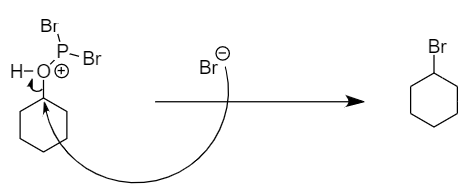
Cyclohexanol on reaction with $ PB{r_3} $ in the presence of pyridine gives:
(A) Bromocyclohexene
(B) Bromocyclohexane
(C) $ 1 - $ bromocyclohexanol
(D) None of the above
Answer
412.2k+ views
Hint :Nucleophilic reactions: These are the type of organic reactions in which a nucleophile i.e., an electron rich species attacks the electron deficient carbon atom and the functional group attached to that carbon is replaced.
Complete Step By Step Answer:
As per given reaction conditions, when cyclohexanol reacts with $ PB{r_3} $ in the presence of pyridine, it follows $ S{N_2} $ nucleophilic substitution reaction.
Bimolecular nucleophilic reaction $ (S{N_2}) $ : These are the nucleophilic reactions in which the rate of reaction depends on both, the nucleophile as well as the reactant taken. In these reactions, bond formation and breaking of bonds takes place simultaneously. So, it is a single step or concerted reaction.
The reaction mechanism is as follows:
Step-1: The lone pair of electrons present on the oxygen atom attack the phosphorus atom and removal of bromine ion takes place. The reaction is as follows:

Step-2: The bromine ion will act as a nucleophile and will attack the carbon atom to replace the unstable functional group formed in the transition state. The reaction is as follows:

Hence, bromocyclohexane is the final product.
Thus, option (B) is the correct answer.
Note :
In $ S{N_2} $ reaction, the nucleophile attacks from the opposite plane relative to the plane in which the functional group is present. Hence a complete inversion in the configuration of the product is observed. The most common example of $ S{N_2} $ reaction is the Walden inversion in which an inversion of configuration for asymmetric carbon is observed.
Complete Step By Step Answer:
As per given reaction conditions, when cyclohexanol reacts with $ PB{r_3} $ in the presence of pyridine, it follows $ S{N_2} $ nucleophilic substitution reaction.
Bimolecular nucleophilic reaction $ (S{N_2}) $ : These are the nucleophilic reactions in which the rate of reaction depends on both, the nucleophile as well as the reactant taken. In these reactions, bond formation and breaking of bonds takes place simultaneously. So, it is a single step or concerted reaction.
The reaction mechanism is as follows:
Step-1: The lone pair of electrons present on the oxygen atom attack the phosphorus atom and removal of bromine ion takes place. The reaction is as follows:

Step-2: The bromine ion will act as a nucleophile and will attack the carbon atom to replace the unstable functional group formed in the transition state. The reaction is as follows:

Hence, bromocyclohexane is the final product.
Thus, option (B) is the correct answer.
Note :
In $ S{N_2} $ reaction, the nucleophile attacks from the opposite plane relative to the plane in which the functional group is present. Hence a complete inversion in the configuration of the product is observed. The most common example of $ S{N_2} $ reaction is the Walden inversion in which an inversion of configuration for asymmetric carbon is observed.
Recently Updated Pages
Master Class 11 Accountancy: Engaging Questions & Answers for Success

Express the following as a fraction and simplify a class 7 maths CBSE

The length and width of a rectangle are in ratio of class 7 maths CBSE

The ratio of the income to the expenditure of a family class 7 maths CBSE

How do you write 025 million in scientific notatio class 7 maths CBSE

How do you convert 295 meters per second to kilometers class 7 maths CBSE

Trending doubts
One Metric ton is equal to kg A 10000 B 1000 C 100 class 11 physics CBSE

Write down 5 differences between Ntype and Ptype s class 11 physics CBSE

Soap bubble appears coloured due to the phenomenon class 11 physics CBSE

Proton was discovered by A Thomson B Rutherford C Chadwick class 11 chemistry CBSE

How is the brain protected from injury and shock class 11 biology CBSE

Define least count of vernier callipers How do you class 11 physics CBSE




